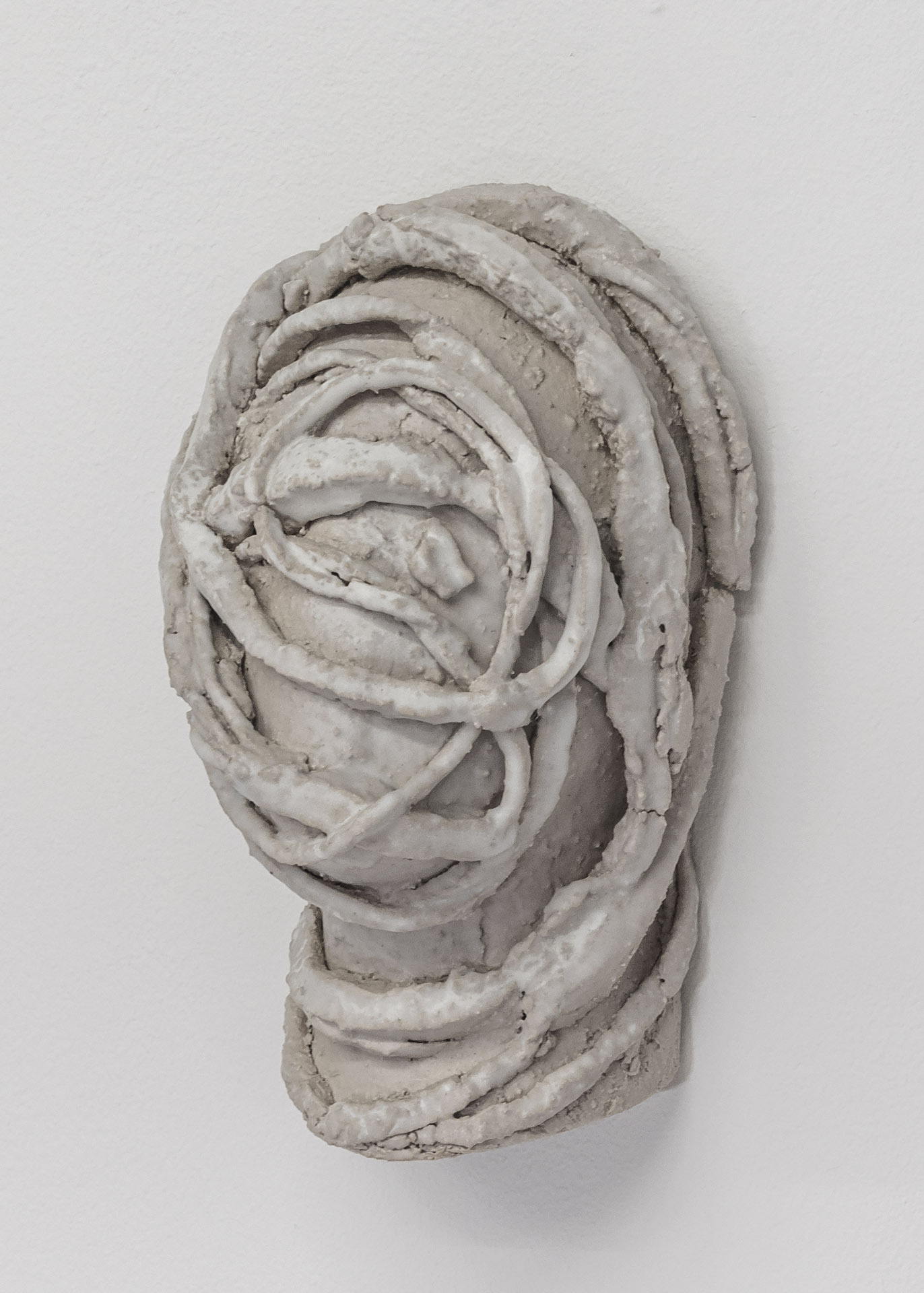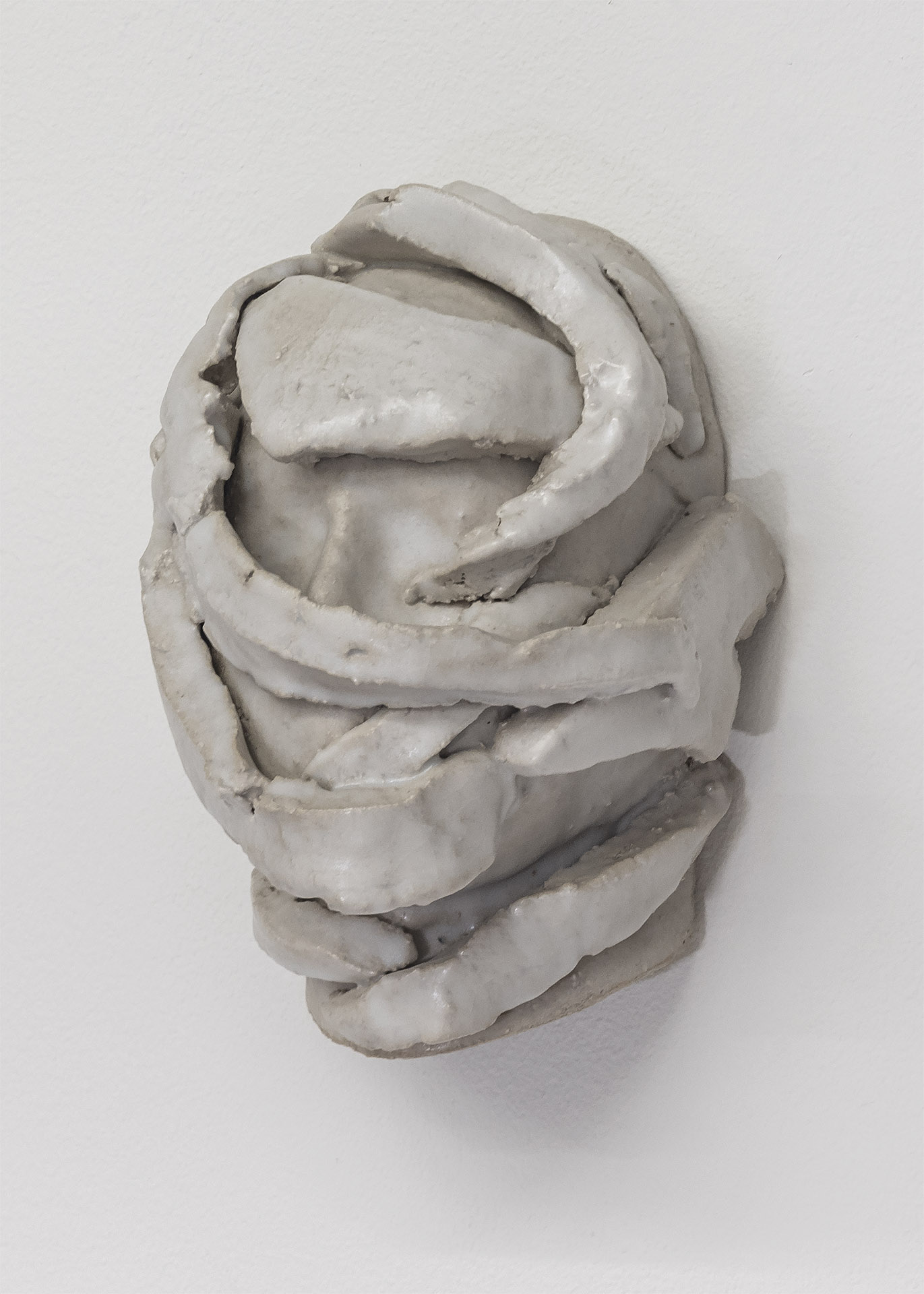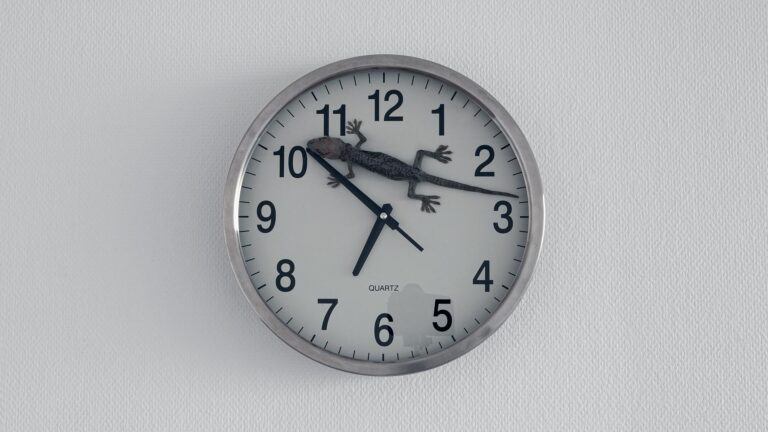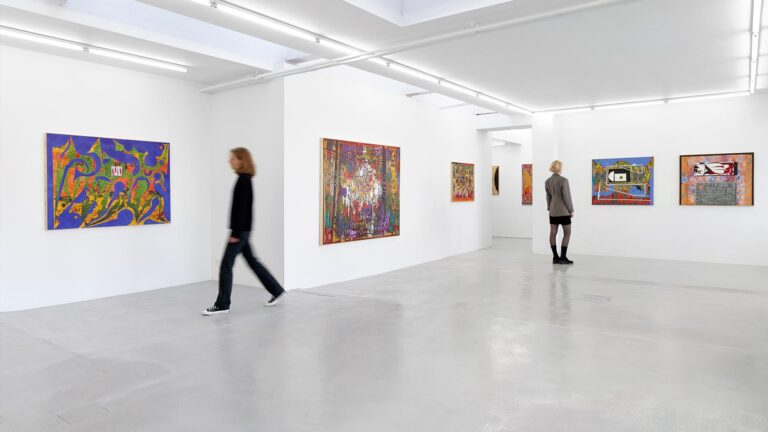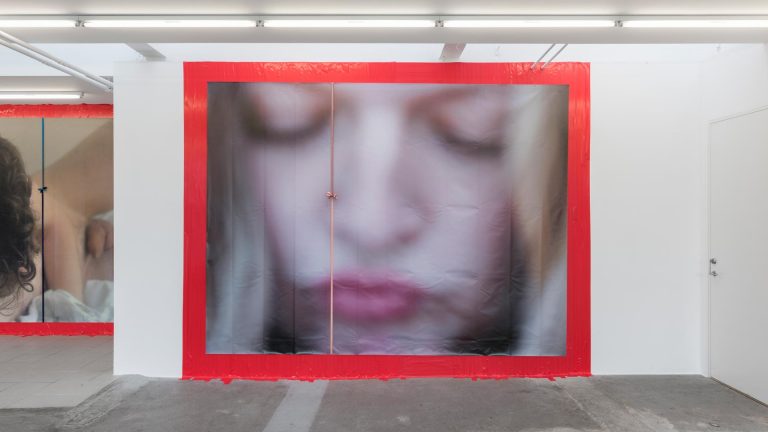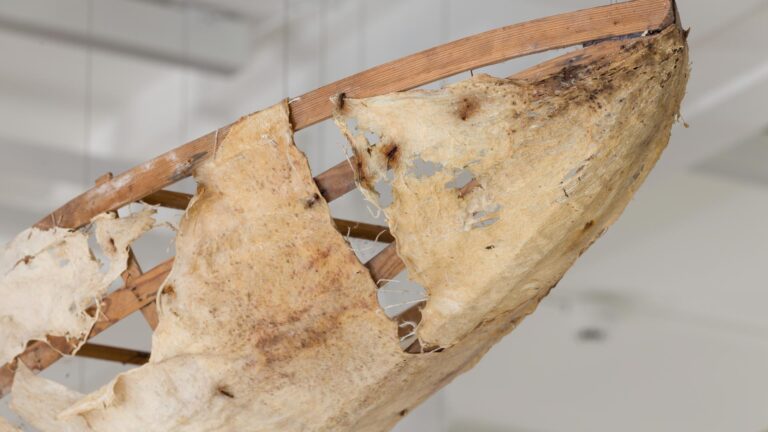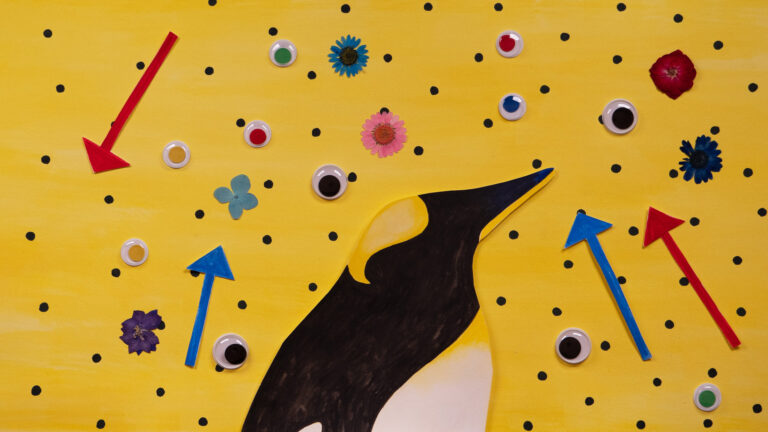Artist: Jan S. Hansen
Exhibition title: Pas Partu
Venue: Kunsthal Nord, Aalborg, Denmark
Date: May 1 – August 28, 2021
Photography: all images copyright and courtesy of the artist and Kunsthal Nord, Aalborg
Territories of consciousness
By Nina Wöhlk
Cosmologies are human’s image of the World in its totality. Through the ages, they have changed in the wake of the achievements of a given time, enforcing development and change. The transformed, external surroundings have influenced beliefs and the sciences, which has helped to frame the everyday life and our understanding of the World. Through the development of new cosmologies, attempts have been made to find meaning in the World-altering shifts.
The mental and physical dimensions of the human consciousness, which the recent, accelerating time has expanded, is the focal point of the investigations in Jan S. Hansen’s exhibition Pas Partu. The exhibition presents a number of condensed understandings of our present time, connecting around the fact that they are all influenced by new technological and neuroscientific discoveries in the world community, defined as “The Cyber Space Age”. Online or away from the keyboard, the Internet’s expansion of our physical and mental reach almost becomes tangible to us when solidarity is found in online communities, and when the mobilisation of movements takes place globally. Our presence has stretched out into the Universe over the last half century, and this expanded spatiality is continuously manifesting itself in our everyday lives. A new hyperreality presents itself, where we, as an example, can observe mediated representations of Mars´ landscapes through screens in the form of photographs, videos and sound clips.
With his exhibition, Jan S. Hansen reflects on the state of things by creating a noticeable silence, giving the impression that the exhibition rooms exist outside of time. This is done by matting the glass in the windows, only letting diffused light enter, while a gray fabric separates the entrance of Kunsthal NORD from the exhibition rooms. Despite the significant industrial traces of the kunsthalle in the form of ventilation pipes, steel beams, and factory glass, the transformation gives the audience the experience of entering another world.
Centrally positioned in the high-ceilinged gallery space is the artwork series “Intermodular Habitat”, which consists of three elements that look like architectural models. The miniatures each appear with few, to the scale, disproportionately large installations; like a spout on a faucet; a gecko divided in two by a partition wall and luminous bulbs placed in rows. As surreal models for human’s ability to calibrate themselves to live in different habitats, the artwork series speaks to a mental and physical readiness for change. In the adjoining room, a fractal star with locusts hangs from the ceiling. The star is a so-called “Herrnhuter Star”, used by the Christian congregation “Brødremenigheden” as a symbol of the city Christiansfeld, near Hansen’s own birthplace. The locusts bring to mind the ten plagues of the Old Testament and set out to see how the Universe has previously and primarily been the domain of religions as well as inspired religious motifs and creation myths. In the work “Retrograde (New Morning Star)”, Hansen draws our attention to parts of the dynamics in the construction of human narratives and worldviews as well as how scientific discoveries challenge one of the territories of religions.
The exhibition contains memory cells of the eye-opening moments of the accelerating time, which alternate between the personal and the collective. With a laser cutter, a small square has been cut out of the middle of the front cover of a Whole Earth Catalog from 1970, picturing one of NASA’s “Blue Marble” photographs of the Earth, as seen from outer space. The catalog is encapsulated in a thick seal of resin and placed on the floor under the title “Pas Partu”. The Whole Earth Catalog was an iconic catalog within “Do It Yourself”, alternative education, and ecology and is said to be a forerunner to the Internet. It can be compared to the free Internet-based encyclopedia, Wikipedia, which is continuously rewritten through the collaborative effort of a global community of users. The work “Pas Partu” points to the double presence of humans in The Cyber Space Age; a double-position, which becomes evident in the recording of new territories. From NASA’s recent mapping and geologic records of past ecosystems and their impact on today’s climate change and the development of new landscapes in the online that allow virtual communities that transcend hierarchies, class and physical affiliations to bodies that live in these landscapes and inhabit the physical and virtual worlds. Human’s conflicted position holds a complexity that was first conceptualized in the map-territory relation, a theory by Alfred Korzybski, where the map is easily confused with the landscape it represents. In other words, the map is a picture of the landscape, but also controls how we read it. Changing times and cultures have always believed that the maps they drew and navigated were objective and transparent. But all maps are always subjective and grounded in a given time and cultural worldview. The work “Pas Partu” shares its title with the exhibition and refers to the passepartout as a symbol of how we develop and frame a subjective image of our time. The title also points to the additional etymological meaning of the word, as a universal key, and thus further covers an underlying drive in human development and science’s search for ways to unlock the riddles that have yet to be uncovered.
An inner, mental key crystallises itself in the artwork “Claustrum (Warped Model of Consciousness in The Cyber Space Age)” in the farthest room of the kunsthalle, that shows a reproduction of the, purportedly, human center for consciousness which is situated in two symmetrical sheet-like structures of gray matter in the brain, and until recently has been inaccessible to researchers1. Through a dialogue with a team of scientists from Atatürk University in Turkey, Hansen has been granted access to work with 3D-files of the brain structure. With a frozen donor, the research team has been able to laser cut a human body into millimetre thin slices and subsequently scan the body to make 3D renderings of the two claustrums. Hansen uses the generated data and files to create artistically modified versions of these in correspondingly millimetre thin layers, rebuilt with 3D printing. In an artistic adaption, Hansen has enlarged and stretched the proportions of the organ lengthwise and materialised a container for consciousness that spatializes the idea of past, present, and future. In this way, the artwork attaches itself to the exhibition’s installations and sculptures, which in pendulum-like movement sway between new and older rejected positions and examine the interplay between body and consciousness, and how they in a cyclical rhythm continuously uncover and (re)discover new grounds.
As a kind of museum for the future, Hansen takes a look at our contemporary history from an outside position. As found, processed, and made objects, the artworks of the exhibition serve as a container for different beliefs and circumstances of the times, where human’s image of themselves and their surroundings was in accordance with the changing industrial progress and existential views. Thus, the exhibition can be seen as a social scientific collection where different times collapse into one another. An expanded notion of time is introduced, where Hansen’s research of the plasticity of the human consciousness appears. This is illustrated in the way the exhibition invites us, through its “passepartout”, to see the objects from a coherent and larger perspective. Further, this “passepartout” creates a space for reflection, where we can look at the actions and values of our time and contemporary history, expanding our consciousness.
____________________________
[1] In this context, “Claustrum” refers to its Latin etymology, namely “enclosure”, “to shut” or “cloister”
Jan S. Hansen (1980, Haderslev, Denmark) lives and works in Copenhagen, Denmark. MFA, 2010, the Royal Danish Academy of Fine Arts, Schools of Visual Arts, Copenhagen. Exhibitions include Overgaden Institute of Contemporary Art and Huset for Kunst og Design. He is co-director of Simian, an exhibition space for contemporary art in Copenhagen.
Jan S. Hansen, Prisma (Past Presents Future), 2021, steel, mannequin, mirror, hammer, suitcases
Jan S. Hansen, Prisma (Past Presents Future), 2021, steel, mannequin, mirror, hammer, suitcases, detail
Jan S. Hansen, Prisma (Past Presents Future), 2021, steel, mannequin, mirror, hammer, suitcases, detail
Jan S. Hansen, Pas Partu, 2021, exhibition view, Kunsthal Nord, Aalborg
Jan S. Hansen, Pas Partu, 2021, exhibition view, Kunsthal Nord, Aalborg
Jan S. Hansen, Pas Partu, 2021, exhibition view, Kunsthal Nord, Aalborg
Jan S. Hansen, Intermodular Habitat, 2021, 65 x 90 x 120 cm, steel, MDF, faucet, drain, miniature telescope
Jan S. Hansen, Intermodular Habitat, 2021, 65 x 90 x 120 cm, steel, MDF, faucet, drain, miniature telescope, detail
Jan S. Hansen, Intermodular Habitat, 2021, 65 x 90 x 120 cm, steel, MDF, doorbell, laser cut gecko
Jan S. Hansen, Intermodular Habitat, 2021, 65 x 90 x 120 cm, steel, MDF, doorbell, laser cut gecko, detail
Jan S. Hansen, Intermodular Habitat, 2021, 65 x 90 x 120 cm, steel, MDF, sockets, bulbs
Jan S. Hansen, Intermodular Habitat, 2021, 65 x 90 x 120 cm, steel, MDF, sockets, bulbs, detail
Jan S. Hansen, Pas Partu, 2021, exhibition view, Kunsthal Nord, Aalborg
Jan S. Hansen, Pas Partu, 2021, 13 x 33 x 43 cm, laser cut catalog, epoxy resin
Jan S. Hansen, Pas Partu, 2021, exhibition view, Kunsthal Nord, Aalborg
Jan S. Hansen, Claustrum (Warped Model of Consciousness in the Cyber Space Age), 2021, 18 x 32 x 100 cm, steel, SLA 3D print
Jan S. Hansen, Retrograde (New Morning Star), 2021, dia 130 cm, lamp, locusts, epoxy resin
Jan S. Hansen, Retrograde (New Morning Star), 2021, dia 130 cm, lamp, locusts, epoxy resin
Jan S. Hansen, Pas Partu, 2021, exhibition view, Kunsthal Nord, Aalborg
Jan S. Hansen, Census, 2021, 50 x 65 cm, steel, glazed stoneware
Jan S. Hansen, Census, 2021, 50 x 65 cm, steel, glazed stoneware
Jan S. Hansen, Mask (Omni), 2021, 18 x 37 cm, glazed stoneware
Jan S. Hansen, Mask (Rhizome), 2021, 18 x 35 cm, glazed stoneware
Jan S. Hansen, Mask (Rhizome), 2021, 18 x 35 cm, glazed stoneware
Jan S. Hansen, Mask (Alter) 2021, 16 x 34 cm, glazed stoneware
Jan S. Hansen, Mask (Screen), 2021, 18 x 34 cm, glazed stoneware
Jan S. Hansen, Mask (Rhizome), 2021, 20 x 30 cm, glazed stoneware
Jan S. Hansen, Mask (Void), 2021, 19 x 35 cm, glazed stoneware
Jan S. Hansen, Mask (Xeno), 2021, 20 x 36 cm, glazed stoneware
Jan S. Hansen, Mask (Rhizome), 2021, 17 x 37 cm, glazed stoneware
Jan S. Hansen, Mask (Omni), 2021, 17 x 35 cm, glazed stoneware
























